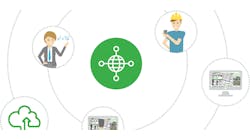Latest from C&E/NetDev Ops/GIS/Open-Source Networks
Educating Customers on the Benefits of NT
I cannot believe how quickly this year is flying by. It seems like it was just yesterday that I was reading the April edition of ISE magazine. Come to think of it, it was yesterday — as I am actually writing this latest chapter of the Network Transformation (NT) story in mid-April.
Just to offer a bit of a recap: in the initial column, in the January issue, I wrote about the WHY behind NT, moving onto the WHAT in the April column, focusing primarily on the regulatory environment. In this issue, I’ll discuss the WHO: the customers that are selected for migration from copper to fiber.
When we started our NT program at Verizon in late 2011 we decided to call it Network Evolution, or NEVO. (We do love our acronyms!) We looked for customers that were having the poorest experience with their copper infrastructure. We called these individuals chronics because they had repeated (i.e., chronic) copper issues within a 12-month period: nearly 3 dispatches a year on average.
We picked this group for 2 big reasons:
Reason #1. They logically seemed to be the ones who would benefit the most from a migration to fiber.
Reason #2. The company would see an immediate benefit in terms of reducing truck-rolls.
These eliminated truck-rolls or dispatches were very significant because our studies showed that these chronic customers accounted for the vast majority of copper dispatches. In fact, we found that 10% of the copper customer base drove more than 75% of the dispatches. It was these savings that helped to fund the cost of connecting the customers to fiber (fiber drops, ONTs, etc.).
As an added benefit, we believed that the ripple effect of eliminated dispatches would actually benefit other, non-chronic, customers because we would be freeing up technicians to address their issues faster.
From a mathematical perspective this was clearly a win-win for everyone involved — unfortunately customers rarely look at things from this vantage point.
Frankly many of the customers with chronic issues were wary of what we were trying to do for them. When we said we wanted to "upgrade" their facilities they assumed additional costs despite our assurances that this was not the case (many customers actually saved money by migrating). All these customers knew about fiber was that it seemed to cost more than what they are paying today; it didn’t matter that they were thinking about a Triple Play ad they saw on TV and we were talking simple plain old telephone service (POTS).
They were also somewhat fearful of this new-fangled (their term, not mine) technology despite the fact that fiber was most likely part of their existing network.
The bottom line was they did not like change. Although they suffered with repeated copper troubles, they were comfortable with their old copper infrastructure. At the time I equated this phenomenon to a recently deceased friend or relative: when they were alive they were a pain in the neck, once they are gone they are remembered as a saint.
It was clear that we needed a massive education program to allay the customers’ fears and to address their concerns — and we could not rely on the Internet alone to deliver this message.
One of the most powerful resources we relied on was our technicians. When we first started the program we routed customers to a special queue in our call centers, but the customers would end up arguing with the reps about the need to migrate, so we tried a little experiment: instead of discussing what might happen before the dispatch, we sent a tech out to discuss what will happen. We quickly learned that the customers trusted the techs a lot more than a voice on the phone.
To make this work we simply created both a copper trouble ticket and a fiber migration service order (orders are needed for a migration in our backend systems) and assigned both to a single tech. This was known as a ghost order.
The rationale behind this was simple; if the trouble could be resolved outside simply (i.e., replacing a drop) or proved to be inside the customer’s location (i.e., IW or a jack) then the tech would close the trouble ticket. If the trouble was caused by a copper cable issue, the tech would migrate the customer to fiber using the ghost order. This process worked well because the majority of our techs knew that fiber was the better technology, and were more than happy to help with the NT program.
Once we developed a process for reactive situations (when the customer initiated things with a repair call to us), we set our sights on creating a proactive process for migrations (that is when the company initiates migrations). This is where Janet Gazlay Martin and Michael White come in.
Janet and Michael run the migrations programs at Verizon and Frontier respectively and both have a wealth of experience dealing with customers who really don’t want to move to fiber.
Janet said, "The key to a successful migration program is good old-fashioned relationship building — doing whatever it takes to make the customers comfortable with their migrations." She noted that this may require a little tough love at times.
Michael observed that engagement is critical — both employees and customers. He said, "In some instances we may need to track down a relative or neighbor to assist the customer with this, but in the end our primary goal is to provide the customer with better service."
Both Janet and Michael touched on a few important aspects of their respective customer education programs. These include:
Senior customer outreach by dedicated teams. These folks are measured on the successful resolution of the customers’ concerns. These contacts are specifically designed to be more personal than your typical service call.
Multi-media/multi-language materials explaining the migration process. The teams knew that it was important to communicate with customers in the manner they are most comfortable with. Again, the goal is to improve, not disrupt the customers’ experience.
Specialized field visits by trained employees. I can personally attest to the effectiveness of this program, having visited many customers myself. These visits include:
• An 82-year-old retiree to explain how they could actually save money. At the end of the day this customer wound up bundling services and saving about $30 to $50 per month.
• Helping another customer with their 80-year-old rotary phone. The new equipment did not generate enough ringing voltage to make it ring, so the team reconfigured the phone to make it work. At the end, the migration was completely transparent to the customer.
Demonstrating the latest technologies in-person to show how they won’t disrupt the customers’ home. In some instances this was done with town-hall meetings (works best in MDUs), while in other cases customers are encouraged to visit a local store for a hands-on kick-the-tires demonstration. (Note: My next column focuses on new advances in FTTH equipment, including the customer-managed 24-hour BBU, naked fiber, and smaller footprint ONTs.
And of course, what-to-expect-videos (e.g., www.verizon.com/fiberupgrade).
While it’s clear that NT offers incentives for carriers and customers alike to move to fiber, there are situations where Mother Nature’s wrath selects customers (actually entire communities) for this change.
Weather-related events like Superstorm Sandy in 2012, the 3 hurricanes that blew through the southern region of the US and Puerto Rico in 2017, and the fires that burned through California last year, all destroyed the existing network infrastructure and required carriers to rebuild their networks. Each of these weather events presented a perfect opportunity to upgrade our networks to fiber.
As a result, even where an existing customer chooses simply to have POTS provisioned over the new fiber infrastructure, their residence is now positioned to take advantage of newer broadband services if/when they choose to do so, and in the interim they get the added benefit of a more robust, more reliable network.
Frank Simone, Vice President-Federal Regulatory for AT&T, sums up the network transformation this way: "Regardless of the reason for the transformation, whether it is for improved customer service, or the customer’s choice, or Mother Nature’s choice, fiber infrastructure provides the path to 21st Century services, and is the doorway to participation in our modern society."
Until my next column in the October issue, I hope you all have a great summer. And remember: wear your sunscreen.





